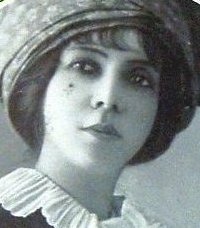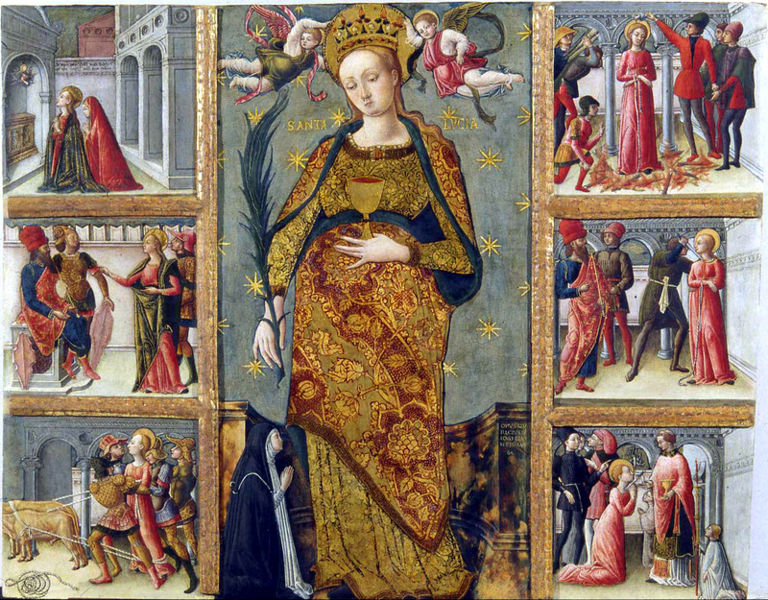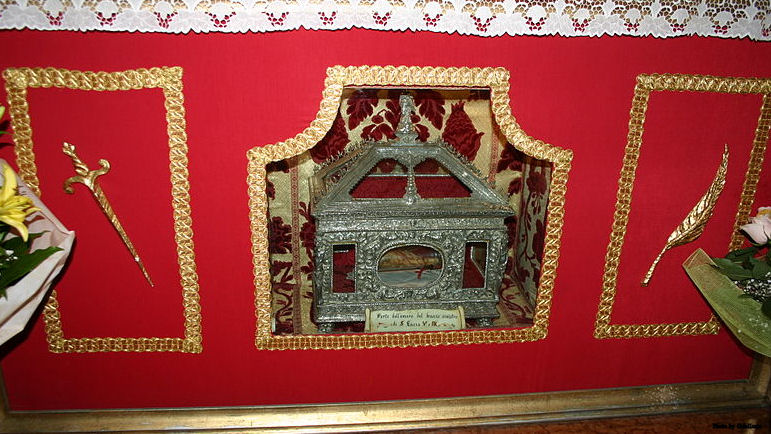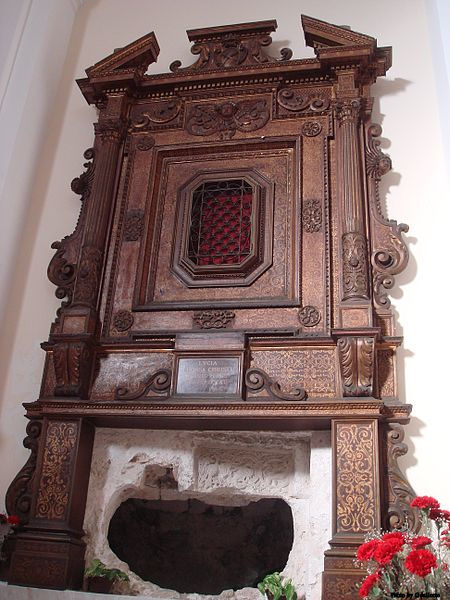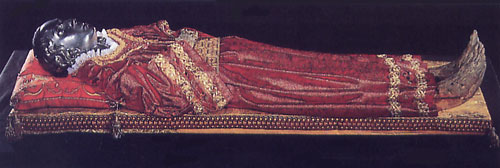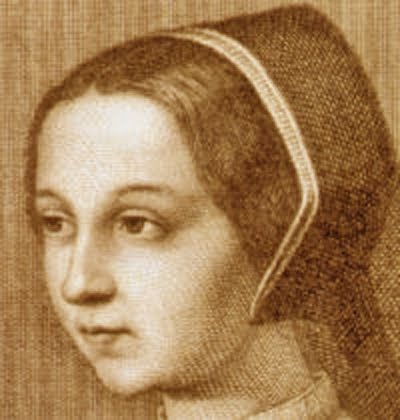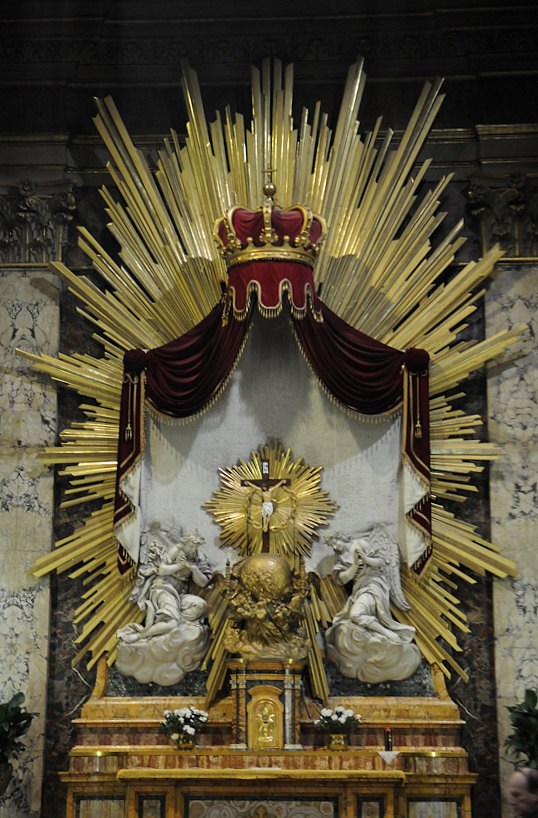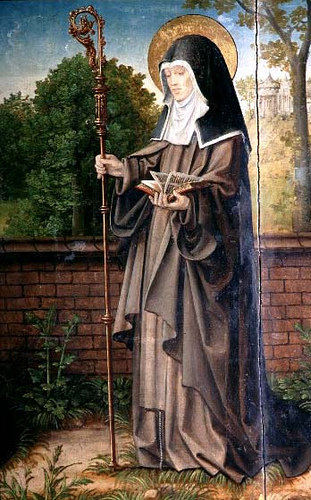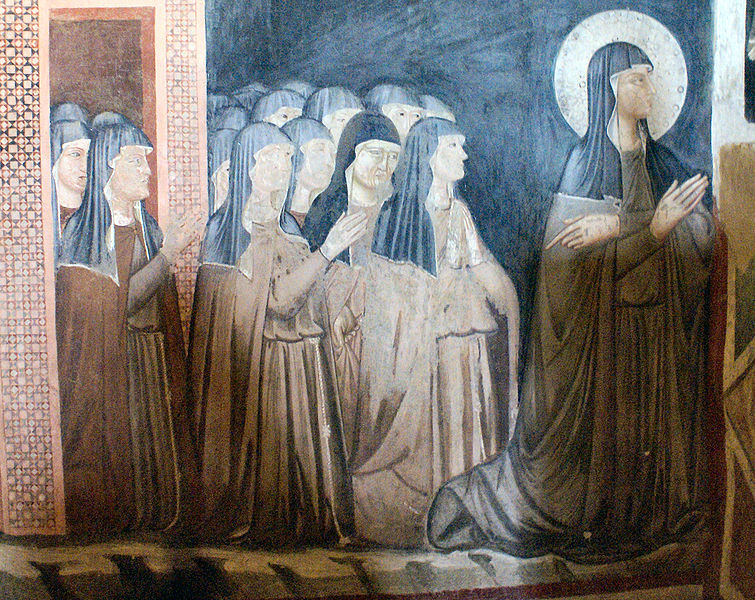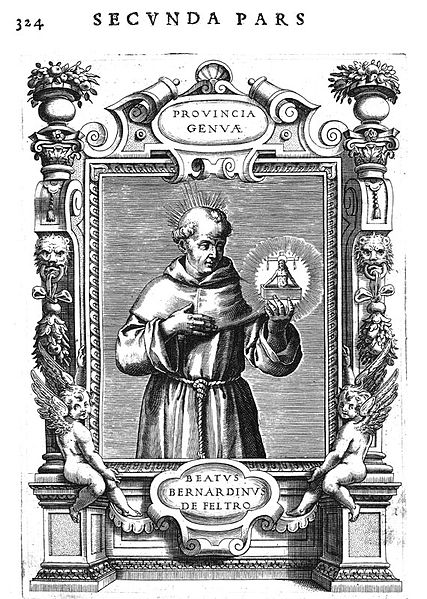November 4 – Fearless and Faithful, He Reformed the Church
St. Charles Borromeo

Painting of young Saint Charles Borromeo by Wolfgang Sauber
Archbishop of Milan, Cardinal-Priest of the Title of St. Prassede,
Papal Secretary of State under Pius IV, and one of the chief factors in
the Catholic Counter-Reformation , was born in the Castle of Arona, a
town on the southern shore of the Lago Maggiore in northern Italy, 2
October, 1538; died at Milan, 3 November, 1584. His emblem is the word
HUMILITAS crowned, which is a portion of the Borromeo shield. He is
usually represented in art in his cardinal’s robes, barefoot, carrying
the cross as archbishop; a rope round his neck, one hand raised in
blessing, thus recalling his work during the plague. His feast is kept
on 4 November. His father was Count Giberto Borromeo, who, about 1530,
married Margherita de Medici. Her younger brother was Giovanni Angelo,
Cardinal de’ Medici, who became pope in 1559 under the title of Pius IV.
Charles was the second son, and the third of six children, of Giberto
and Margherita. Charles’ mother died about the year 1547, and his father
married again.
His early years were passed partly in the Castle of Arona, and partly
in the Palazzo Borromeo at Milan. At the age of twelve his father
allowed him to receive the tonsure, and, upon the resignation of his
uncle, Julius Caesar Borromeo, he became titular Abbot of Sts. Gratinian
and Felinus at Arona.
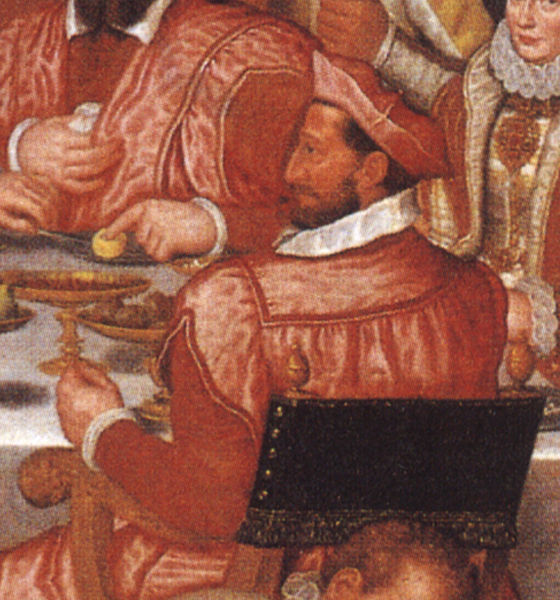
Painting of St. Charles Borromeo by Anthony Bays
When he received the tonsure he was sent by his father to Milan,
where he studied Latin under J.J. Merla. In October, 1552, he left Arona
for the University of Pavia, where he had as his tutor Francesco
Alciato, afterwards cardinal. His correspondence shows that he was
allowed a small sum by his father, and that often he was in very
straitened circumstances, which caused him considerable inconvenience.
It was not only that he himself suffered, but that his retinue also were
not suitably clothed. Charles evidently felt bitterly his humiliation,
but he does not seem to have shown impatience. Leaving Pavia to meet his
uncle, Cardinal de’ Medici, at Milan, he was, within a few weeks called
upon to attend the funeral of his father, who died early in August,
1558, and was buried in the church of Santa Maria delle Grazie, Milan.
Fresh responsibilities at once came to Charles, for though he was not
the elder son, yet, at the request of his family, including even his
brother, he assumed charge of all the family business. The question of
possession of the Castle of Arona was one of great difficulty, as it was
claimed by both France and Spain. Charles conducted the negotiations
with great energy and diplomatic skill, and as a consequence of the
Peace of Cambrai (3 April, 1559) the castle was handed over to Count
Francesco Borromeo, in the name of his nephew, Federigo Borromeo, to be
held by him for the King of Spain. He also did much to restore to their
ancient monastic discipline the religious of his Abbey of Sts. Gratinian
and Felinus. Though his studies were so often interrupted, yet his
seriousness and attention enabled him to complete them with success, and
in 1559 he maintained his thesis for the doctorate of civil and canon
law.
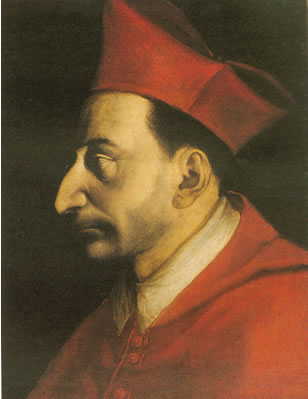
Painting by Giovanni Ambrogio Figino
In the summer of 1559, Paul IV died, and the conclave for the
election of his successor, which began on 9 September, was not concluded
till 26 December, when Cardinal Giovanni Angelo de’ Medici was elected
and took the name of Pius IV. On the 3rd of January, 1560, Charles
received a message by a courier from the pope, asking him to proceed at
once to Rome. He started immediately for the Eternal City, but though he
travelled rapidly he was not in time for the pope’s coronation (6
January). On 22 January he wrote to Count Guido Borromeo that the pope
had given him the charge of the administration of all the papal states.
On 31 January he was created cardinal-deacon, together with Giovanni de’
Medici, son of the Duke of Florence, and Gianantonio Serbellone, cousin
of the pope. Charles was given the title of Sts. Vitus and Modestus,
which was in the August following changed to that of St.
Martino-ai-Monti. He wished for no rejoicings at Milan; all the
celebration was to be at Arona, where were to be said ten Masses
de Spiritu Sancto.
At this time Cardinal Ippolito d’Este, of Ferrara, resigned the
Archbishopric of Milan, and on 8 February the pope named Charles as
administrator of the vacant see. In succession he was named Legate of
Bologna, Romagna, and the March of Ancona. He was named Protector of the
Kingdom of Portugal, of Lower Germany, and the Catholic cantons of
Switzerland. Under his protection were placed the orders of St. Francis,
the Carmelites, the Humiliati, the Canons Regular of the Holy Cross of
Coimbra, the Knights of Jerusalem (or Malta), and those of the Holy
Cross of Christ in Portugal. By a
motu proprio (22 January, 1561) Pius IV gave him an annual income of 1000 golden crowns from the episcopal
mensa of Ferrara.
Charles’ office of secretary of state and his care for the business
of the family did not prevent him from giving time to study, and even to
recreations in the form of playing the lute and violoncello, and a game
of ball. He lived at first at the Vatican, but in July, 1562, removed
to the Palazzo Colonna, Piazza Sancti Apostoli. Soon after his arrival
in Rome he founded at the Vatican an academy, which was a way of
providing, by literary work, a distraction from more serious
occupations. The members, whether ecclesiastics or laymen, met nearly
every evening, and many of their contributions are amongst the works of
Charles as “Noctes Vaticanœ”. Charles was very soon occupied as
secretary of state in using his influence to bring about the
re-assembling of the Council of Trent, which had been suspended since
1552. The state of Europe was appalling from an ecclesiastical point of
view. Many were the difficulties that had to be overcome — with the
emperor, with Philip II of Spain, and, greatest of all, with France,
where the demand was made for a national council. Still, in spite of
obstacles, the work went on with the view of re-assembling the council,
and for the most part it was Charles’ patience and devotion that
accomplished the object.
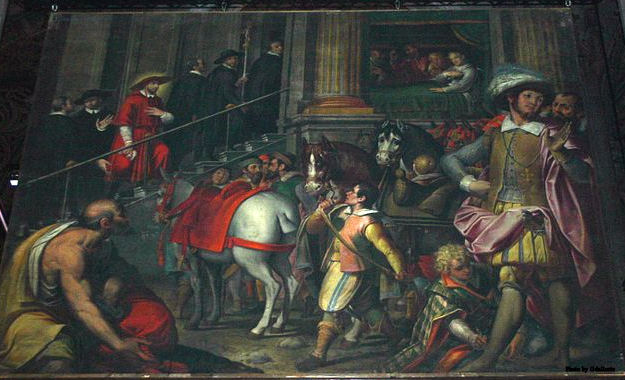
Once
a year, in the Cathedral in Milan, Italy, in November and December, the
“Quadroni of St. Charles” is exhibited. “Quadroni” mean “big
paintings.” St. Charles Borromeo visiting the ill. Painting by Giovanni
Dall’Orto
It was not until 18 January, 1562, that the council resumed at Trent,
with two cardinals, 106 bishops, 4 mitred abbots, and 4 generals of
religious orders present. The correspondence which passed between
Charles and the cardinal legates at Trent is enormous, and the questions
which arose many times threatened to bring about the breaking-up of the
council. Difficulties with the emperor, the national principles put
forward on behalf of France by the Cardinal Charles of Lorraine,
Archbishop of Reims, required from Charles constant attention and the
greatest delicacy and skill in treatment. The twenty-fifth, and last,
session of the council was held 3 and 4 December, 1563; at it were
present 255 Fathers. At a consistory on the 26th of January, 1564, Pius
IV confirmed the decrees of the council, and later appointed a
congregation of eight cardinals to see to the execution of these
decrees. During the sitting of the re-assembled council Charles’ elder
brother, Count Federigo, had died (28 November, 1562). This event had a
very determining result as to Charles, for he immediately resolved to
give himself with greater strictness to spiritual matters, and he looked
upon his brother’s death as a warning to him to give up all worldly
things. His resolution was well needed, for, as he was now head of the
family, great pressure was brought to bear upon him to give up the
ecclesiastical state and to marry. This view was even suggested to him
by the pope at the instance of other relatives. Some months passed in
these efforts to influence Charles, but finally he resolved to
definitely fix himself in the ecclesiastical state by being secretly
ordained priest. The ordination took place, by the hands of Cardinal
Federigo Cesa, in Santa Maria Maggiore, on the 4th of September, 1563.
He writes that he celebrated his first Mass on the Assumption, in St.
Peter’s, at the altar of the Confession. He said his second Mass at his
house, attached to the Gesu, in an oratory where St. Ignatius had been
accustomed to celebrate. Charles at this time had as his confessor
Father Giovanni Battista Ribera, S.J. On the 7th of December, 1563, the
feast of St. Ambrose, he was consecrated bishop in the Sistine Chapel;
on the 23rd of March, 1564, he received the pallium, and was preconized
on the 12th of May. In the following June his title was changed to that
of Santa Prassede.
Meanwhile Charles had provided for the spiritual wants of his
diocese. Antonio Roberti, in May, 1560, had, as his vicar, taken
possession of his archbishopric, and Charles sent Monsignor Donato,
Bishop of Bobbio, as his deputy for episcopal functions. Monsignor
Donato soon died, and in his place, Charles commissioned Monsignor
Girolamo Ferragato, O.S.A., one of his suffragans, to visit the diocese,
and to report on its needs. Ferragato entered Milan, 23 April, 1562; on
24 June of the same year Charles sent to Milan Fathers Palmio and
Carvagial, S.J., with the object of preparing the faithful of the
diocese, both clergy and laity, for the carrying out of the reforms
prescribed by the Council of Trent. While anxious for the spiritual
welfare of his flock, he was no less solicitous for his own. There came
to him the thought of what was the will of God concerning him, and
whether he was to continue as the spiritual father of his diocese or
retire to a monastery. It happened in the autumn of 1563, between the
sessions of the Council of Trent, that the Cardinal of Lorraine went to
Rome, accompanied by Ven. Bartholomew of the Martyrs, O.P., Archbishop
of Braga, in Portugal (see BARTHOLOMEW OF BRAGA). Bartholomew had
already shown himself to be of a like spirit to Charles, and when Pius
IV introduced them, and suggested that he should begin the reform of the
cardinals in the person of Charles, Bartholomew answered that if the
princes of the Church had all been like Cardinal Borromeo, he would have
proposed them as models for the reform of the rest of the clergy. In a
private interview, Charles opened his heart to Bartholomew and told him
of his thought of retiring to a monastery. Bartholomew applauded his
desire, but at the same time declared his opinion that it was God’s will
that he should not abandon his position. Charles was now assured that
it was his duty to remain in the world; but all the more he felt he
ought to visit his diocese, though the pope always opposed his
departure. Bartholomew counselled patience, and represented the
assistance he could give to the pope and the whole Church by remaining
in Rome. Charles was satisfied, and stayed on, doing the great work
necessary by sending zealous deputies. After the Council of Trent he was
much occupied with the production of the catechism embodying the
teaching of the council, the revision of the Missal and Breviary. He
also was a member of a commission for the reform of church music, and
chose Palestrina to compose three masses; one of these is the “Missa
Papæ Marcelli”.
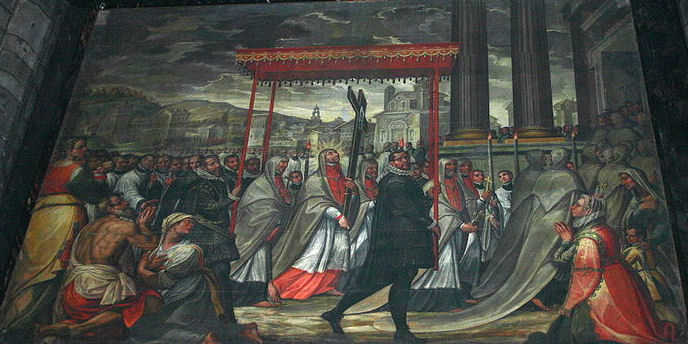
“Saint Charles goes in procession with the Holy Nail”, Painting by Giovanni Dall’Orto
Pastoral solicitude, which is the characteristic chosen for mention
in the collect of his feast, made him ever anxious to have the most
suitable representatives in Milan. He heard of the excellent qualities
of Monsignor Nicolò Ormaneto, of the diocese of Verona, and succeeded in
obtaining the consent of his bishop to his transference to Milan.
Ormaneto had been in the household of Cardinal Pole, and also the
principal assistant of the Bishop of Verona. On the 1st of July, 1564,
Ormaneto reached Milan, and at once carried out Charles’ instructions by
calling together a diocesan synod for the promulgation of the decrees
of the Council of Trent. There were 1200 priests at the Synod. It was
with the clergy that Charles began the reform, and the many abuses
needed skilful and tactful treatment. Father Palmio contributed much in
bringing the clergy to a sense of the necessity for reform. The synod
was followed by a visitation of the diocese by Ormaneto. In September
Charles sent thirty Jesuit Fathers to assist his vicar; three of these
were placed over the seminary, which was opened on the 11th of November
(feast of St. Martin of Tours). Charles was constantly directing the
work of restoration of ecclesiastical discipline, and the education of
the young, even down to minute details, was foremost in his thoughts.
The manner of preaching, repression of avaricious priests,
ecclesiastical ceremonies, and church music are some of the subjects on
which Charles wrote many letters. The revival of strict observance of
rule in the convents of nuns was another matter to which Charles urged
Ormaneto’s attention; the setting up of grilles in the convent parlours
was ordered, and, to remove material difficulties, Charles ordered his
agent, Albonese, to pay the cost of this where the convents, through
poverty, were unable to bear the expense. This order brought
difficulties with his own relations. Two of his aunts, sisters of Pius
IV, had entered the Order of St. Dominic; they resented the setting up
of the grilles as casting a slur on their convent. Charles, in a letter
(28th of April, 1565) displaying much thought and great tact, strove to
bring his aunts to see the good purpose of the order, but without
success, and the pope wrote on the 26th of May, 1565, telling them that
he had given general orders for the setting up of the grilles, and that
it would be pleasing to him that those united to him by ties of blood
and affection should set a good example to other convents.
Notwithstanding the support which Charles gave, Ormaneto was
discouraged by the checks with which he met, and wished to return to his
own diocese. Charles pressed the pope to allow him to leave Rome, and
at the same time encouraged Ormaneto to remain. At last the pope gave
his consent to Charles visiting his flock and summoning a provincial
council; but, desiring his stay to be short one, he created Charles
legate
a latere for all Italy. Charles prepared to start, chose
canonists to help the council, and wrote to the Court of Spain and
Philip II. He left Rome 1 September, and, passing through Florence,
Bologna, Modena, and Parma, he made his solemn entry into Milan on
Sunday, 23 September, 1565. His arrival was the occasion of great
rejoicings, and the people did their utmost to welcome the first
resident archbishop for eighty years. On the following Sunday he
preached in the Duomo, on the words: “With desire I have desired to eat
this pasch with you” (Luke, xxii, 15).

Choir stall of St. Peter und Paul in Weißenau
On the 15th of October the first provincial council met. It was
attended by ten out of the fifteen bishops of the province, those absent
being represented by their procurators. Three of these prelates were
cardinals, and one, Nicolò Sfondrato of Cremona, was afterwards pope
with the title of Gregory XIV. Charles announced that the reform must
begin with the prelates: “We ought to walk in front, and our spiritual
subjects will follow us more easily.” He commenced by fulfilling all
things required in himself, and his wonderful clergy astonished the
prelates. The council was finished on the 3rd of November, and Charles
sent a minute report to the pope. On the 6th of November he went to
Trent as legate, to meet the Archduchesses Giovanna and Barbara, who
were to be married to the Prince of Florence and the Duke of Ferrara.
Charles conducted Barbara to Ferrara and Giovanna to Tuscany, where at
Fiorenzuola, he received the news of the pope’s serious illness. He
reached Rome to find that the pope’s condition was hopeless, and he at
once bade the Holy Father turn all his thoughts to his heavenly home. On
the 10th of December Pius IV died, assisted by two saints, Charles and
Philip Neri. On the 7th of January, 1566, the conclave for the election
of his successor was concluded by the election of Cardinal Michele
Ghislieri, O.P., of Alessandria, Bishop of Mondovi, who, at the request
of Charles, took the name of Pius V. It had been maintained that Charles
at first favoured Cardinal Morone, but his letter to the King of Spain
(Sylvain, I, 309) seems to prove that he did his utmost to secure the
election of Cardinal Ghislieri.
Pius V wished to keep Charles to assist him in Rome; but though
Charles delayed his departure for some time, in the end his earnest
representations obtained permission for him to return to Milan, at least
for the summer. He returned to his see, 5 April, 1566, having made a
detour to visit the sanctuary of Our Lady of Loreto. Charles showed
admirably how the Church had the power to reform from within, and,
though the task he had to do was gigantic, he set about its execution
with great calmness and confidence. He began with his household, gave up
much of his property to the poor, and insisted that in all that
concerned him personally the greatest economy should be used; for his
position as archbishop and cardinal he required due respect. He
practised great mortification, and whatever the Council of Trent or his
own provincial council had laid down for the life of the bishops he
carried out, not only in the letter, but also in the spirit.
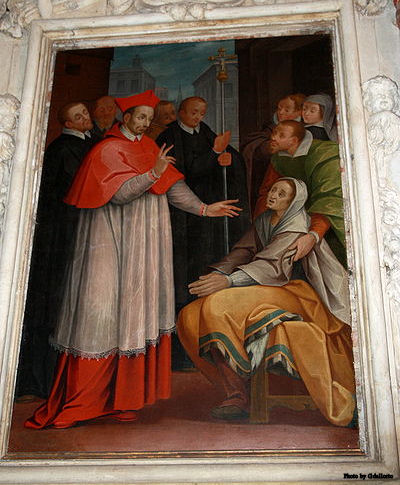
A miracle by St. Charles. Painting by Giovanni Dall’Orto
The rules for the management of his household, both in spiritual and
temporal affairs, are to be found in the “Acta Ecclesiæ Mediolanensis”.
The result of the care that was taken of his household was seen in the
many members of it who became distinguished bishops and prelates. More
than twenty were chosen while members of the cardinal’s household; one
of these was Dr. Owen Lewis, fellow of New College, Oxford, who taught
at Oxford and Douai, and after being vicar-general to St. Charles was
made Bishop of Cassano in Calabria.
The administration of the diocese needed to be perfected; he
therefore chose a vicar-general of exemplary life, learned in law and
ecclesiastical discipline. He also appointed two other vicars, one for
civil and the other for criminal causes. He associated with them other
officials, all chosen for their integrity, and took care that they
should be well paid, so as to preclude all suspicion of venality.
Corruption in such matters was specially distasteful to him. Whilst
providing for upright officials, the needs of the prisoners were not
forgotten, and in time his court was known as the holy tribunal. He so
organized his administration that by means of reports and conferences
with the visitors and the vicars forane, his pastoral visits were
productive of great fruit. The canons of his cathedral chapter were in
turn the object of his reforming care. He put before them his plan of
giving them definite work in theology and in connexion with the
Sacrament of Penance. They welcomed his reforms, as he wrote to
Monsignor Bonome: “The result of the way I have taken is very different
to that in vogue to-day” (27 April, 1566). Pius V congratulated Charles
on his success and exhorted him to continue the work.
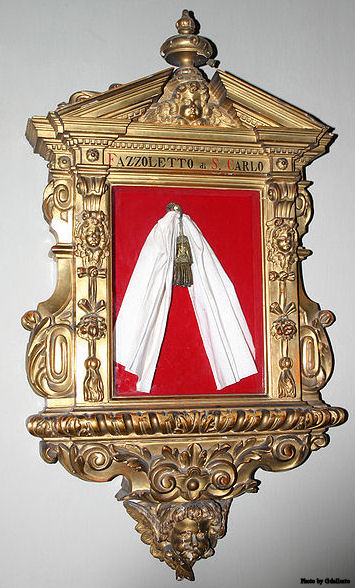
Handkerchief belonged to St. Charles Borromeo, in Saint Charles’ chapel in the church of San Carlo al Corso church in Milan.
Another great work which was begun at this time was that of the
Confraternity of Christian Doctrine, in order that the children might be
carefully and systematically instructed. This work was really the
beginning of what is now known as the Sunday school, and there is a
remarkable testimony to this in an inscription under a statue outside
the Essex Unitarian Church, Kensington, London, where Cardinal Borromeo
is mentioned in connexion with the work. The visitation of his flock was
steadily carried out and various pious foundations were made to succour
the needy and sinners. In 1567 opposition began to be made to his
jurisdiction. The officials of the King of Spain announced that they
would inflict severe penalties on the archbishop’s officers if they
imprisoned any more laymen, or carried arms. The matter was referred to
the king, and finally to the pope, who counselled the Senate of Milan to
support the ecclesiastical authority. Peace was not restored; and the
bargello,
or sheriff, of the archbishop was imprisoned. The archbishop announced
sentence of excommunication on the captain of justice and several other
officials. Much trouble followed, and again the matter was laid before
the pope, who decided in favour of the archbishop.
In October, 1567, Charles started to visit three Swiss valleys,
Levantina, Bregno, and La Riviera. In most parts, indeed, there was much
to reform. The clergy especially were in many cases so lax and
careless, and even living scandalous lives, that the people had grown to
be equally negligent and sinful. The hardships of this journey were
great; Charles travelled on a mule, but sometimes on foot, over most
difficult and even dangerous ground. His labours bore great fruit, and a
new spirit was put into both clergy and laity. In August, 1568, the
second diocesan synod was held, and it was followed in April, 1569, by
the second provincial council. In August, 1569, matters came to a head
in connexion with the collegiate church of Santa Maria della Scala. This
church had been declared by Clement VII, in 1531, exempt from the
jurisdiction of the Archbishop of Milan, provided that the consent of
the archbishop was obtained; but this consent had never been obtained,
and consequently the exemption did not take effect. Now the governor,
the Duke of Albuquerque, had been induced by the opponents of the
archbishop to issue an edict declaring that all who violated the king’s
jurisdiction should receive severe punishment. The canons of La Scala
claimed exemption from the archbishop and relied on the secular power to
support them. Charles announced his intention of making his visitation
in accordance with the wishes of the pope, by sending Monsignor Luigi
Moneta to the canons. He was met with opposition and open insult. Early
in September Charles himself went, vested for a visitation. The same
violent demeanour was again shown. The archbishop took the cross into
his own hands and went forward to pronounce the sentence of
excommunication. The armed men raised their weapons; the canons closed
the door of the church against Charles, who with eyes fixed on the
crucifix, recommended himself and these unworthy men to the Divine
protection. Charles was indeed in danger of his life, for the canons’
supporters opened fire, and the cross in his hand was damaged. His
vicar-general then put up the public notice that the canons had incurred
censures. This act was followed by blows and cries, removal of the
notices, and the declaration that the archbishop was himself suspended
from his office. Pius V was shocked at this incident, and only with very
great difficulty allowed Charles to deal with these rebellious canons,
when they repented.
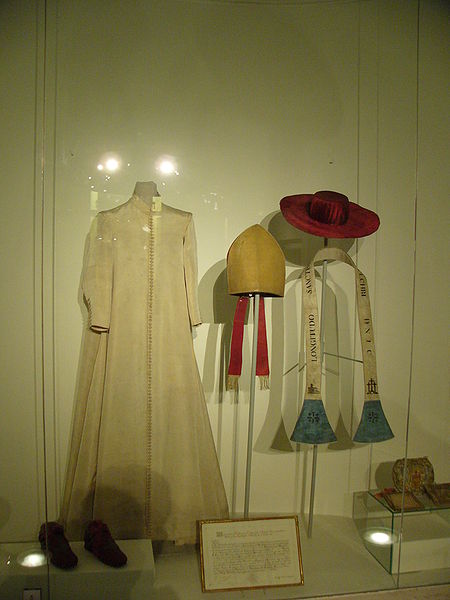
Clothes of Charles Borromeo in “Museo Borromeo” museum in Karlskirche Wien (Austria).
In October, 1569, Charles was again in great danger. The Order of the
Humiliati, of which he was protector, had by his persevering care been
induced to accept certain reforms, in 1567. But some of its members
strove to bring about a return to their former condition. As Charles
would not consent to this, some of the order formed a conspiracy to take
his life. On the 26th of October, whilst Charles was at evening prayer
with his household, a member of the Humiliati, dressed as a layman,
having entered with others of the public who were admitted to the
chapel, took his stand four or five yards from the archbishop. The motet
“Tempus est ut revertar ad eum qui me misit”, by Orlando Lasso, was
being sung; the words “Non turbetur cor vestrum, neque formidet” had
just been sung, when the assassin fired his weapon, loaded with ball,
and struck Charles, who was kneeling at the altar. Charles, thinking
himself mortally wounded, commended himself to God. A panic arose, which
allowed the assassin to escape, but Charles motioned to his household
to finish the prayers. At their conclusion it was found that the ball
had not even pierced his clothes, but some of the shot had penetrated to
the skin, and where the ball had struck a slight swelling appeared,
which remained through his life.
It was seen how far the unruly-minded had gone, and the serious turn
affairs had taken. At once the governor took prompt steps to assure
Charles of his sympathy and his wish to find the assassin. Charles would
not allow this, and asked the governor to use his efforts to prevent
the rights of the Church being infringed. In some measure this
occurrence led the canons of La Scala to sue for pardon, and on the 5th
of February, 1570, Charles publicly absolved them before the door of his
cathedral. Notwithstanding his wish to forgive those who had attempted
his life, and his efforts to prevent their prosecution, four of the
conspirators (amongst them Farina, who actually fired) were sentenced to
death. All being of the clergy, they were handed over to the civil
power (29 July, 1570); two were beheaded; Farina and another were
hanged.
Charles at this time made a second visit to Switzerland, first
visiting the three valleys of his diocese, then over the mountains to
see his half-sister Ortensia, Countess d’Altemps. Afterwards he visited
all the Catholic cantons, everywhere using his influence to remove
abuses both among the clergy and laity, and to restore religious
observance in monasteries and convents. He visited Altorf, Unterwalden,
Lucerne, Saint Gall, Schwyz, Einsiedeln, where he said that he nowhere
except at Loreto, experienced a greater religious feeling (10 September,
1570). Heresy had spread in many of these parts, and Charles sent to
them experienced missionaries to win back those who had embraced it.
At this time Pius V came to the conclusion that nothing less than the
suppression of the Order of the Humiliati was adequate. He therefore
issued a Bull (7 February, 1571) suppressing the order and providing for
its property. This same year, owing to the short harvest, the whole
province suffered from a terrible famine, during which Charles worked
with unceasing toil to help the starving, relieving at his own expense
as many as 3000 daily for three months. His example induced others to
help, the governor, especially, giving large alms. In the summer of 1571
Charles was for some time seriously ill, in the month of August; having
partly recovered, he was making his visitation when he heard of the
serious illness of the governor, the Duke of Albuquerque. Charles
returned to Milan only in time to console the duchess. He made use of
the prayers ordered by Pius V for the success of the Christians against
the Turks, to urge on his flock the necessity of averting God’s anger by
penance. Great were the rejoicings at the victory of Lepanto (7
October, 1571). Charles was especially interested in this expedition by
reason of the papal ships being commanded by Marco Antonio Colonna,
whose son Fabricio was married to his sister, Anna Borromeo.
The archbishop remained in bad health, suffering from low fever and
catarrh. It was feared that consumption would set in; in spite of his
illness he prepared for the third diocesan synod, which was held in his
absence in April, 1572. He soon afterwards heard of the death of Pius V
(1 May, 1572), and, though feeble, he started for the conclave, which
lasted one day and resulted in the election of Cardinal Ugo
Buoncompagni, with the title of Gregory XIII, 13 May, 1572. As medical
treatment had not restored Charles to health, he now abandoned it and
returned to his ordinary rule of life, with the result that he was
before long quite well. On his homeward journey he again visited Loreto,
in November, and reached Milan on 12 November. He at this time resigned
the offices of Grand Penitentiary, Archpriest of Santa Maria Maggiore,
and other high dignities. In April, 1573, he held his third provincial
council.
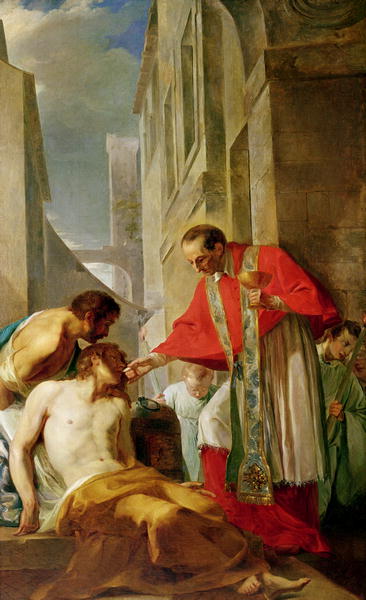
St. Charles Borromeo healing the Plague vicitims and giving the Sacraments to the dying. Painting by Jean-Baptiste Corneille
The new governor of Milan was Don Luigi di Requesens, who had known
Charles in Rome. However, as soon as he took office, being urged by the
opponents of Charles, he published some letters falsely incriminating
Charles in questions of the royal authority and containing much that was
contrary to the rights of the Church. Charles protested against their
publication; with great reluctance, and after much anxious deliberation,
he publicly pronounced, in August, sentence of excommunication
explicitly against the grand chancellor and implicitly against the
governor. As a consequence of this, libels were published in the city
against Charles. The governor showed his displeasure by placing
restrictions on the meetings of the confraternities, also depriving
Charles of the Castle of Arona. Various rumours were in circulation of
more wicked plans against Charles, but his tranquility was maintained,
and he carried on his work with his usual care, despite the fact that
the governor had placed an armed guard to watch his palace. None of the
governor’s actions succeeding, the governor was led to ask for
absolution, which he obtained by deception. When Gregory XIII learned of
this, he compelled the governor to make satisfaction to Charles. This
was done, and on 26 November Charles announced that the governor was
absolved from all penalties and censures. In this year Charles founded a
college for the nobility at Milan.
In August, 1574, Henry III of France was passing through the Diocese
of Milan on his way from Poland to take the French throne. Charles met
him at Monza. The fourth diocesan synod was in November, 1574. Gregory
XIII proclaimed a jubilee for 1575, and on the 8th of December, 1574,
Charles left for Rome. He visited many shrines and, having reached Rome,
performed the required devotions and started for Milan, in February. He
assisted at the death-bed of his brother-in-law, Cesare Gonzaga, and
continued the visitation of his province. In 1576 the jubilee was kept
in the Diocese of Milan. It began on the 2nd of February. Whilst the
jubilee was being celebrated, news came of the outbreak of plague in
Venice and Mantua. The fourth provincial council was held in May. In
August, Don John of Austria, visited Milan. Religious exercises were
being carried out, and his arrival was made the occasion of rejoicings
and spectacular effects. All at once everything was changed, for the
plague appeared in Milan. Charles was at Lodi, at the funeral of the
bishop. He at once returned, and inspired confidence in all. He was
convinced that the plague was sent as a chastisement for sin, and sought
all the more to give himself to prayer. At the same time he thought of
the people. He prepared himself for death, made his will (9 September,
1576), and then gave himself up entirely to his people. Personal visits
were paid by him to the plague-stricken houses. In the hospital of St.
Gregory were the worst cases; to this he went, and his presence
comforted the sufferers. Though he worked so arduously himself, it was
only after many trials that the secular clergy of the town were induced
to assist him, but his persuasive words at last won them so that they
afterwards aided him in every way. It was at this time that, wishing to
do penance for his people, he walked in procession, barefooted, with a
rope round his neck, at one time bearing in his hand the relic of the
Holy Nail.
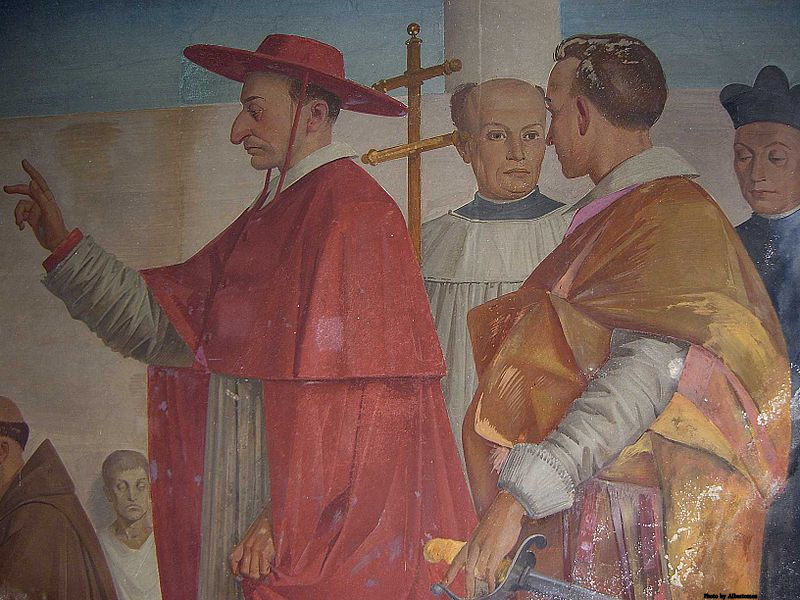
A fresco of St. Charles Borromeo in Villasanta
At the beginning of 1577 the plague began to abate, and though there
was a temporary increase in the number of cases, at last it ceased. The
Milanese vowed to build a church dedicated to St. Sebastian, if he would
deliver them. This promise was fulfilled. Charles wrote at this time
the “Memoriale”, a small work, addressed to his suffragans, which had
for its object to recall the lessons given by the cessation of the
plague. He also compiled books of devotion for persons of every state of
life. By the beginning of 1578 the plague had quite disappeared from
all parts. At the end of 1578 the fifth diocesan synod was held. It
lasted three days. Charles endeavoured at this time to induce the canons
of the cathedral to unite with himself in community life. In this year,
on the 16th of August, he began the foundation of the congregation of
secular priests under the patronage of Our Lady and St. Ambrose, giving
it the title of the Oblates of St. Ambrose. Though he had been helped by
various orders of religious, especially by the Jesuits and the
Barnabites, one of whom (now Bl. Alexander Sauli) was for many years his
constant adviser, yet he felt the need of a body of men who could act
as his assistants and, living in community, would be more easily
impressed by his spirit and wishes. He was the master mind of this new
congregation, and he ever insisted on the need of complete union between
himself and its members. It was his delight to be with them, and,
looking to him as a father, they were ready to go where he wished, to
undertake works of every kind. He placed them in seminaries, schools,
and confraternities. The remaining synods were held in 1579 and
succeeding years, the last (the eleventh) in 1584.
His first pilgrimage to Turin, to visit the Holy Shroud, was in 1578.
About this time he first visited the holy mountain of Varallo to
meditate on the mysteries of the Passion in the chapels there. In 1578-9
the Marquis of Ayamonte, the successor of Requesens as governor,
opposed the jurisdiction of the archbishop, and in September of the
latter year Charles went to Rome to obtain a decision on the question of
jurisdiction. The dispute arose in consequence of the governor ordering
the carnival to be celebrated with additional festivities on the first
Sunday of Lent, against the archbishop’s orders. The pope confirmed the
decrees of the archbishop, and urged the Milanese to submit. The envoys
sent by them were so ashamed that they would not themselves present the
pope’s reply. Gregory XIII had welcomed Charles and rejoiced at his
presence. Charles did much work during his stay for his province,
especially for Switzerland. In connection with the rule which Charles
drew up for the Oblates of St. Ambrose, it is to be noted that when in
Rome he submitted it to St. Philip Neri, who advised Charles to exclude
the vow of poverty. Charles defended its inclusion, so St. Philip said,
“We will put it to the judgment of Brother Felix”. This brother was a
simple Capuchin lay brother at the Capuchins, close to the Piazza
Barberini. St. Philip and St. Charles went to him, and he put his finger
on the article dealing with the vow of poverty, and said, “This is what
should be effaced”. Felix was also a saint, and is known as St. Felix
of Cantalicio. Charles returned to Milan by Florence, Bologna, and
Venice, everywhere reviving the true ecclesiastical spirit. When he
reached Milan the joy of his people was great, for it had been said he
would not return. After the beginning of Lent (1580), Charles began his
visitation at Brescia; soon after, in April, he was called back to Milan
to assist at the death-bed of the governor, Ayamonte. In this year
Charles visited the Valtelline valley in the Grisons. In July he was
brought to know a youth who afterwards reached great sanctity. He was
invited by the Marquis Gonzaga to stay with him, and refused, but while
staying at the archpriest’s house he met the eldest son of the marquis,
Luigi Gonzaga, then twelve years old, now raised to the altars of the
Church as St. Aloysius Gonzaga, S.J. Charles gave him his first
Communion. The next year (1581) Charles sent to the King of Spain a
special envoy in the person of Father Charles Bascape of the Barnabites,
charging him to endeavour to come to an understanding on the question
of jurisdiction. The result was that a governor, the Duke of Terra Nova,
was sent, who was instructed to act in concert with Charles. After this
no further controversy arose.
In
1582 Charles started on his last journey to Rome, both in obedience to
the decrees of the Council of Trent, and to have the decrees of the
sixth provincial council confirmed. This was his last visit, and during
it he resided at the monastery attached to his titular church of Santa
Prassede, where still are shown pieces of furniture used by him. He left
Rome in January, 1583, and travelled by Sienna and Mantua, where he had
been commissioned by the pope to pronounce a judgment. A great portion
of this year was taken up by visitations. In November he began a
visitation as Apostolic visitor of all the cantons of Switzerland and
the Grisons, leaving the affairs of his diocese in the hands of
Monsignor Owen Lewis, his vicar-general. He began in the Mesoleina
Valley; here not only was there heresy to be fought, but also witchcraft
and sorcery, and at Roveredo it was discovered that the provost, or
rector, was the foremost in sorceries. Charles spent considerable time
in setting right this terrible state of things. It was his especial care
to leave holy priests and good religious to guide the people. Next he
visited Bellinzona and Ascona, working strenuously to extirpate heresy,
and meeting with much opposition from the Bishop of Coire. The
negotiations were continued into the next year, the last of Charles on
earth. All his work bore fruit, and his efforts in these parts ensured
the preservation of the Faith. The heretics spread false reports that
Charles was really working for Spain against the inhabitants of the
Grisons. In spite of their falsehoods Charles continued to attack them
and to defend Catholics, who had much to suffer.
At the end of 1584 he had an attack of erysipelas in one leg, which
obliged to remain in bed. He however has a congress of the rural deans,
sixty in number, with whom he fully discussed the needs of the diocese.
He also made great exertions to suppress the licentiousness of the
carnival. Knowing the needs of the invalids who left the great hospital
he determined to found a convalescent hospital. He did not live to see
it completed, but his immediate successor saw that the work was
executed. During September and early October he was at Novara, Vercelli,
and Turin. On the 8th of October he left Turin and thence traveled to
Monte Varallo. He was going to prepare for death. His confessor, Father
Adorno, was told to join him. On 15 October he began the exercises by
making a general confession. On the 18th the Cardinal of Vercelli
summoned him to Arona to discuss urgent and important business. The
night before Charles spent eight hours in prayer on his knees. On the
20th he was back at Varallo; on the 24th an attack of fever came on; he
concealed it at first, but suffering from sickness he was obliged to
declare his state. For five days this state lasted, but still he said
Mass and gave Communion daily, and carried on his correspondence. He
seemed to know that death was at hand and determined to work as long as
he had strength left. The foundation of the college at Ascona was not
completed, and it was urgent that it should be finished in a short time,
so Charles pressed on and started, in spite of his sufferings, on 29
October, having previously paid a farewell visit to the chapels. He was
found prostrate in the chapel where the burial of Our Lord was
represented. He rode to Arona, thence went by boat to Canobbio, where he
stayed the night, said Mass on the 30th, and proceeded to Ascona. He
visited the college, and afterwards set out at night for Canobbio,
staying a short time at Locarno, where he intended to bless a cemetery,
but, finding himself without his pontifical vestments, he abandoned the
idea. When he reached Canobbio the fever was decreasing, and he was very
weak. The next day he took the boat for Arona and stayed there with the
Jesuits, at the novitiate he had founded, and on All Saints’ Day he
said Mass for the last time, giving Communion to the novices and many of
the faithful. The next day he assisted at Mass and received Holy
Communion. His cousin, René Borromeo, accompanied him on the boat, and
that evening he reached Milan. It was not known there that he was ill.
He at once was visited by doctors, whose orders he obeyed. He would not
allow Mass to be said in his room. A picture of Our Lord in the tomb was
before him, together with two others of Jesus at Gethsemani and the
body of the dead Christ. The physicians regarded the danger as extreme,
and though there was a slight improvement, it was not maintained, and
the fever returned with great severity. The archpriest of the cathedral
gave him the Viaticum, which he received vested in rochet and stole. The
administration of extreme unction was suggested. “At once”, Charles
replied. It was at once given, and afterwards he showed but little sign
of life. The governor, the Duke of Terra Nova, arrived after great
difficulty in getting through the crowds which surrounded and had
entered the palace. The prayers for a passing soul were said, the
Passion was read, with Father Bascapè and Father Adorno at the bedside,
the words “Ecce venio” (Behold I come) being the last words he was heard
to utter (3 November, 1584). On the 7th of November his requiem was
sung by Cardinal Nicolò Sfondrato, Bishop of Cremona, afterwards Gregory
XIV. He was buried at night in the spot which he had chosen.
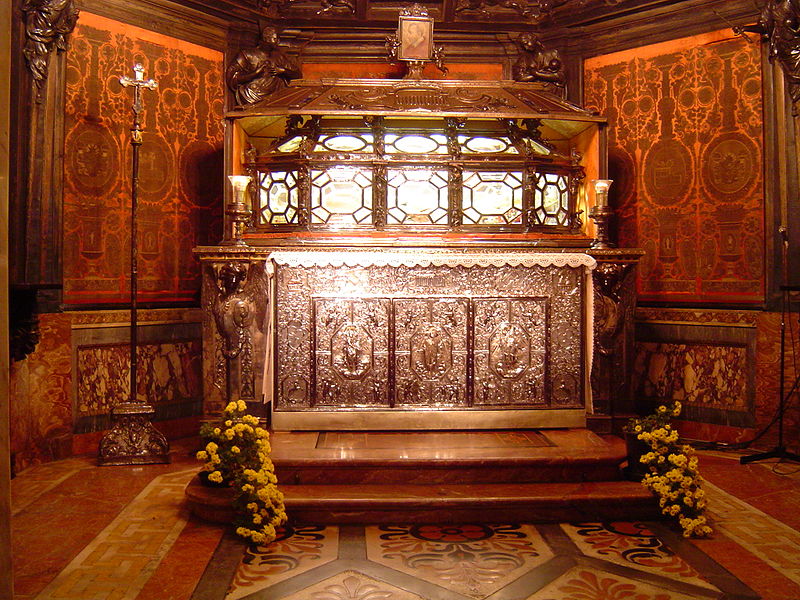
The Crypt of Saint Charles Borromeo, in the Duomo di Milano, Italy.
Devotion to him as a saint was at once shown and gradually grew, and
the Milanese kept his anniversary as though he were canonized. This
veneration, at first private, became universal, and after 1601 Cardinal
Baronius wrote that it was no longer necessary to keep his anniversary
by a requiem Mass, and that the solemn Mass of the day should be sung.
Then materials were collected for his canonization, and processes were
begun at Milan, Pavia, Bologna, and other places. In 1604 the cause was
sent to the Congregation of Rites. Finally, 1 November, 1610, Paul V
solemnly canonized Charles Borromeo, and fixed his feast for the 4th day
of November.
The position which Charles held in Europe was indeed a very
remarkable one. The mass of correspondence both to and by him testifies
to the way in which his opinion was sought. The popes under whom he
lived — as has been shown above — sought his advice. The sovereigns of
Europe, Henry III of France, Philip II, Mary, Queen of Scots, and others
showed how they valued his influence. His brother cardinals have
written in praise of his virtues. Cardinal Valerio of Verona said of him
that he was to the well-born a pattern of virtue, to his brother
cardinals an example of true nobility. Cardinal Baronius styled him “a
second Ambrose, whose early death, lamented by all good men, inflicted
great loss on the Church”.
It is a matter of interest to know that Catholics in England late in
the sixteenth or at the beginning of the seventeenth century had
circulated some life of St. Charles in England. Doubtless some knowledge
of him had been brought to England by Blessed Edmund Campion, S.J., who
visited him at Milan in 1580, on his way to England, stopped with him
some eight days, and conversed with him every day after dinner. Charles
had much to do with England in the days of his assistance to Pius IV,
and he had a great veneration for the portrait of Bishop Fisher. Charles
also had much to do with Francis Borgia, General of the Jesuits, and
with Andrew of Avellino of the Theatines, who gave great help to his
work in Milan.
The complete works of St. Charles — “Noctes Vaticanæ” and “Homilies” —
were edited by J.A. Sassi and published in five volumes (Milan,
1747-8). The “Acta Ecclesiæ Mediolanensis” contain many works not
included in the edition of Sassi. They were first published in 2 vols.,
Milan, 1599, and there have been several reprints, the last forming
vols. II and III of the “Acta Eccl. Med.” Vol. I of this edition will
contain Acts previous to, and vol. IV Acts subsequent to, St. Charles.

![[Image]](http://friarsminor.org/ss.gif)


